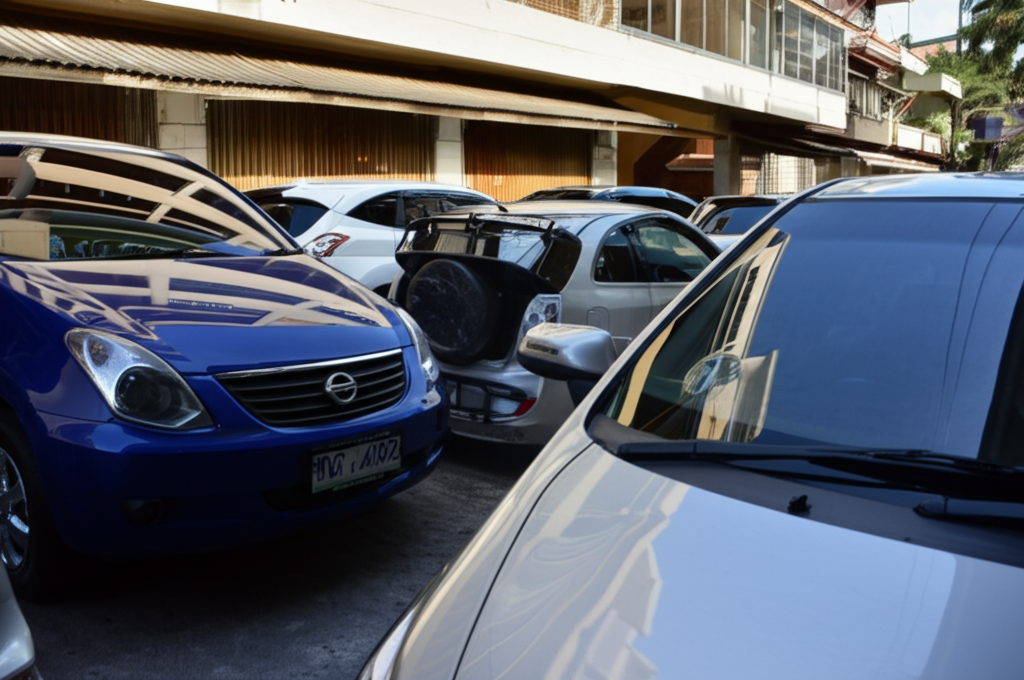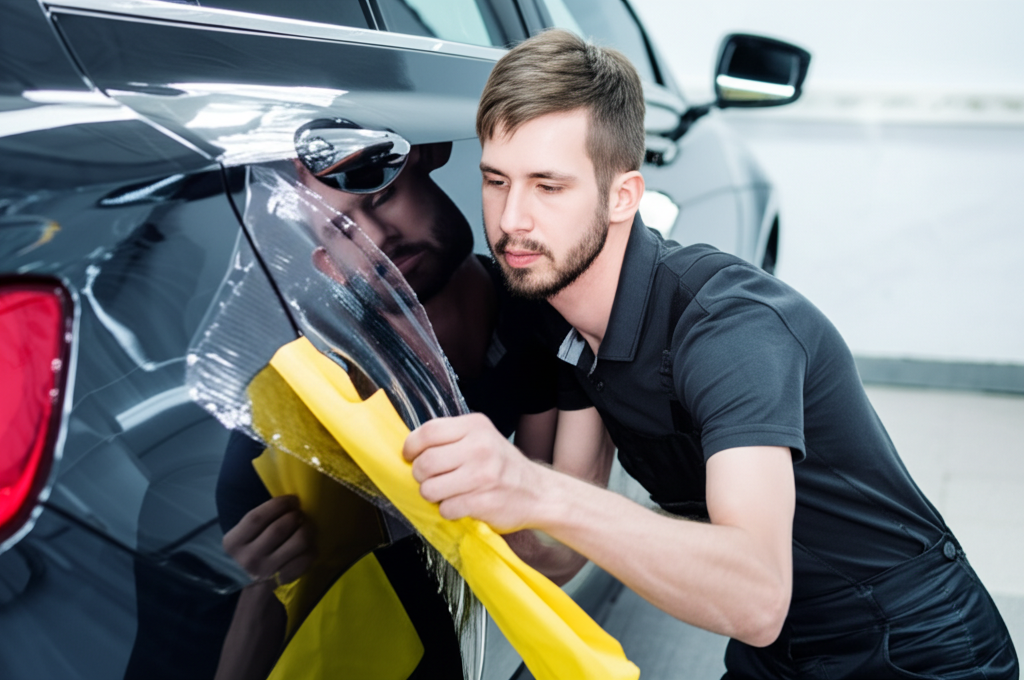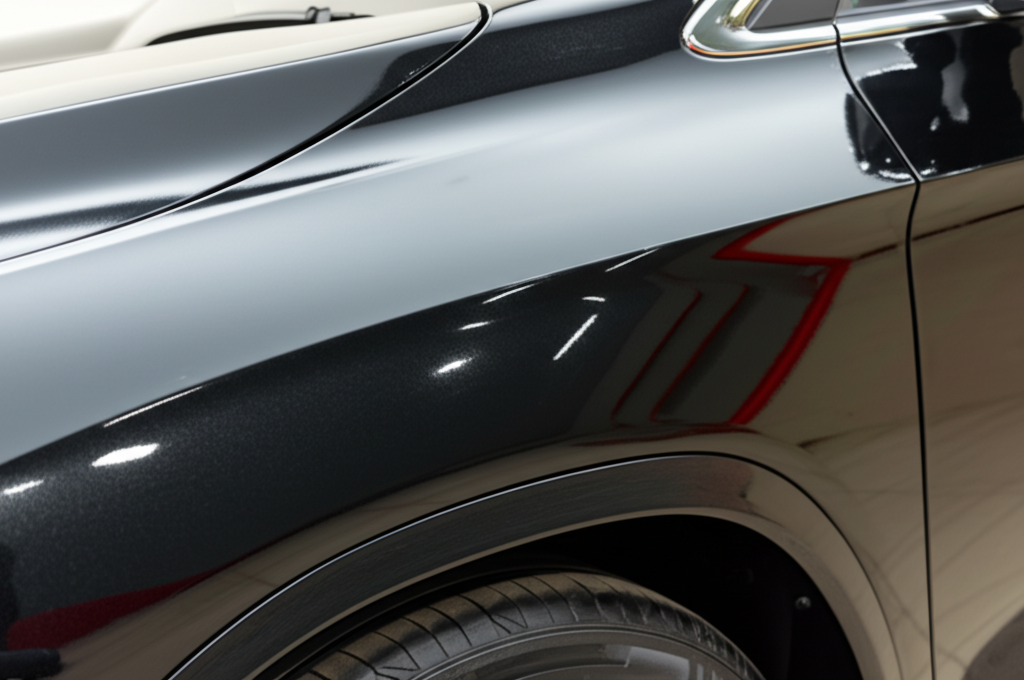Living in Bangkok, or any bustling Thai city, means embracing the vibrant energy. But it also often means dealing with the daily stress of finding parking, especially in residential buildings. Squeezing your pride and joy into a narrow condo parking space feels like a gamble every single time. You leave your car pristine, only to return later and find that dreaded new scuff mark or tiny dent on the door. It’s frustrating, isn’t it? That sinking feeling when you see a careless door swing from the car next door has left its mark. You start wondering: is there *any* way to protect my car’s paintwork from these unavoidable minor collisions in shared parking areas?

One Bangkok Condo Dweller’s Solution: Mr. Tanawat’s Story
Meet Mr. Tanawat, a resident of a popular Sukhumvit condominium. Like many, he recently invested in a new car, a sleek Japanese sedan. The joy of his new purchase, however, was quickly overshadowed by parking anxiety. His designated spot was flanked by two large SUVs, leaving minimal room to maneuver or open doors. “Every day, I worried,” Tanawat recalls. “I’d check my car meticulously, dreading the discovery of a new scratch. It wasn’t just about the cost of repair; it was the constant stress knowing my car was vulnerable, especially the doors and fenders which are prime targets in tight spots.”
After seeing a neighbour’s car wrapped in a glossy, seemingly invisible layer, Tanawat inquired and learned about Paint Protection Film (PPF), specifically the high-quality Thermoplastic Polyurethane (TPU) variant. Intrigued by its promise of self-healing and impact absorption, he decided to invest. He opted for partial protection, focusing on the most vulnerable areas: the full front bumper, headlights, side mirrors, door edges, door handle cups, and crucially, the entire length of all four doors. The application process took a day at a reputable local shop. The change wasn’t visually drastic – the high-quality TPU film was virtually invisible – but the change in Tanawat’s peace of mind was immediate. “A few weeks later,” he shares, “I noticed a small scuff mark on my driver’s side door. My heart sank. But when I looked closer, the mark was only on the film. I parked it in the sun for an afternoon, and like magic, the light scratch disappeared thanks to the self-healing property. Another time, I’m fairly certain the car next to me opened their door onto mine, but the film took the brunt – no paint damage underneath. It’s been a game-changer for my parking stress.”

Understanding TPU Film: Protection Beyond the Shine
So, what exactly is this TPU film that brought Mr. Tanawat such relief, and how much protection can you realistically expect? TPU stands for Thermoplastic Polyurethane. It’s a significant upgrade from older PVC (Polyvinyl Chloride) films. Think of it as a high-tech, multi-layered shield for your car’s paint.
Its key advantage lies in its unique properties:
- Self-Healing: Minor scratches and swirl marks, often caused by washing or light scuffs, can disappear with the application of heat (like sunlight or warm water). The polyurethane molecules rearrange themselves back to their original smooth state.
- Impact Absorption: TPU has elastomeric properties, meaning it can stretch and absorb energy. This is crucial for defending against those dreaded door dings, stone chips, and minor bumps from shopping carts or adjacent vehicles in tight parking lots. While it won’t stop a major collision, it provides remarkable resistance against the everyday impacts that plague city drivers.
- Stain Resistance: High-quality TPU films resist staining from bug splatter, bird droppings, mineral deposits, and acid rain. They also often incorporate UV inhibitors to prevent the film itself from yellowing and protect the underlying paint from sun damage.
- Clarity and Gloss: Modern TPU films are incredibly clear, often enhancing the paint’s natural gloss and depth. Unlike older films, they don’t typically have an “orange peel” texture.
- Durability: Reputable TPU films can last anywhere from 5 to 10 years or even longer, depending on the quality, installation, and maintenance.
How does it compare to having no protection or older film types?
| Feature | High-Quality TPU Film | Standard Paint (No Film) | Older PVC Film |
|---|---|---|---|
| Minor Scratch Resistance | Excellent (often self-healing) | Poor (scratches easily) | Moderate (can scratch, no self-healing) |
| Impact Absorption (Door Dings, Stone Chips) | Good to Excellent (absorbs light impacts) | Very Poor (dents and chips easily) | Poor to Moderate |
| Durability / Lifespan | 5-10+ years | Lifetime of car (but degrades/damages) | 2-5 years (can yellow/crack) |
| Clarity / Appearance | Excellent (virtually invisible, enhances gloss) | N/A (original paint) | Fair to Good (can have texture, may yellow) |
| UV Protection | Good to Excellent (protects paint) | Varies (clear coat offers some) | Poor to Fair |
| Stain Resistance | Good to Excellent | Fair (vulnerable to etching) | Fair to Poor |
| Relative Price | High | N/A | Medium |
| Ideal User | Owners seeking maximum protection, especially in urban areas; preserving resale value. | Budget-conscious; low-risk parking environments. | Lower budget protection; less demanding use. |
How much剐蹭 (guǎ cèng – scraping/scratching) can TPU really buffer? For the typical scenarios in tight Bangkok parking lots – minor door bumps from adjacent cars opening carelessly, light scrapes against pillars or walls during maneuvering, bag or clothing scuffs – high-quality TPU provides excellent protection. It acts as a sacrificial layer. The film might get marked, but your expensive factory paint underneath remains untouched. The self-healing property takes care of many light surface scratches. For slightly harder impacts, like a firm door ding, the film’s thickness and elasticity absorb a significant amount of energy, often preventing paint chipping or denting altogether, though a very sharp or forceful impact might still cause damage beneath.
It’s crucial to have realistic expectations. TPU film isn’t armour plating. It won’t prevent damage from a significant collision, deep key scratches from vandalism, or major dents from heavy impacts. However, for the constant, low-level threats faced in crowded city parking, it’s arguably the best defence available.
Voices from the Parking Garage: Owner Experiences
Don’t just take our word for it. Here’s what other car owners in Thailand are saying after installing TPU film:
“Living in a condo near Asoke, parking is always tight. Before PPF, I collected small scratches like souvenirs I didn’t want. Since getting TPU on the doors and bumpers, I sleep better. Found a door ding mark on the film last month – paint underneath was perfect. Huge relief!” – Priya K., Sathorn Resident
“I was hesitant because of the cost, but my new EV has beautiful metallic paint I wanted to protect. The TPU film is invisible but tough. Already saved me from a nasty scrape against a concrete pillar in my apartment’s underground parking. Worth every Baht compared to a repaint!” – Chai S., Phra Khanong Car Owner
“My kids aren’t always careful opening the rear doors in parking lots. The door edge guards and full door TPU wrap have prevented so many potential chips and scratches against other cars or walls. Less stress for me, less chance of arguments!” – Nattida P., Mother of two, Bang Na
The common theme? A significant reduction in anxiety and the satisfaction of knowing their investment is protected from the everyday hazards of urban driving and parking.
Ready to Shield Your Car from Parking Woes?
If the stress of tight parking spots and the fear of discovering new scratches or dings resonates with you, investing in high-quality TPU paint protection film could be the solution. It’s particularly effective for those high-contact areas like doors, bumpers, and side mirrors – the exact spots most vulnerable in Bangkok’s challenging parking environments. Protect your paint, preserve your car’s value, and most importantly, regain your peace of mind.
Want to learn more about TPU film options for your specific vehicle and get a personalized quote? Contact the experts today.
📱 Want to learn more about car wrap & paint protection?
Feel free to reach us on LINE:

🌐 Official Website: https://tpuwraps.com
Frequently Asked Questions (FAQ)
- Q: What kind of scratches can TPU film realistically protect against?
- A: TPU excels at protecting against light to moderate scratches: swirl marks from washing, fingernail scratches around door handles, scuffs from bags or clothing, light bush scratches, and minor door contact from adjacent cars in parking lots. Its self-healing properties often make very light scratches disappear. It also significantly absorbs impact from small stone chips and minor door dings, often preventing paint damage.
- Q: Will TPU film change the look or colour of my car’s paint?
- A: High-quality, professionally installed clear TPU film is virtually invisible. It has high optical clarity and typically enhances the gloss and depth of the underlying paint. It does not change the paint colour. Matte TPU options are also available if you desire a satin finish.
- Q: How long does TPU paint protection film last in Thailand’s climate?
- A: Durability depends on the film quality, installation, and how well it’s maintained. Reputable brands installed correctly can last from 5 to 10 years or more, even in Thailand’s heat and humidity. Look for films with good UV resistance and warranties against yellowing, cracking, or peeling.
- Q: Is TPU film very expensive compared to just repainting scratches?
- A: TPU film represents a significant upfront investment, typically costing more than a simple touch-up or even repainting a single panel. However, consider the cumulative cost and hassle of multiple repairs over the years. High-quality factory paint is often hard to match perfectly. PPF protects the original paint, preserving the car’s resale value and saving you from repeated repair visits and the associated stress. For many, the long-term protection and peace of mind justify the cost.
- Q: Can TPU film be removed? Will it damage the original paint?
- A: Yes, professional-grade TPU film can be safely removed by a trained technician. When removed correctly, it should not damage the underlying factory paint, provided the paint was in good condition (original, not a poor-quality respray) before application. The adhesive is strong but designed to release without pulling paint.
Invest in Peace of Mind, Not Just Paint Protection
Navigating the tight confines of urban parking in Thailand doesn’t have to be a constant source of anxiety. While careful driving and parking are essential, some situations are simply unavoidable when space is limited and neighbours might be less cautious. TPU paint protection film offers a robust, technologically advanced buffer against the common scrapes, scratches, and minor impacts that plague city vehicles. It’s more than just a protective layer; it’s an investment in preserving your car’s aesthetic appeal, maintaining its value, and significantly reducing the daily stress associated with urban car ownership. Stop worrying about every little mark and start enjoying your drive, knowing your paintwork has the best defence possible.
